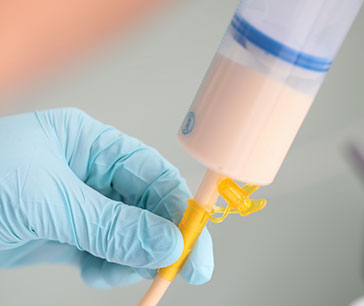Table Of Contents

Roshan Deshmukh

Akhilesh Animesh Prabhugaonkar
Enteral Feeding Formulas: Why Should Your Medical Business Invest in this Sector?

Highlights:
- Enteral feeding and its evolution
- What are the different types of enteral feeding formulas?
- Strategies for businesses to capitalize on the opportunities in the industry
Enteral feeding is the use of artificial external methods for intake of food when regular consumption isn’t possible due to reasons such as injury, disease, old age, etc. In most cases, enteral feeding involves the insertion of a tube directly into the stomach or small intestine through which the food is passed. Enteral feeding, as a concept, has been around since ancient times; historians have pointed out that enteral feeding for the diseased people was a common phenomenon in ancient Egypt.
However, enteral feeding in modern times gained traction after the invention of post-pyloric tube placement in 1910. The next step in the evolution of enteral feeding has been developing technology for delivering liquid nutrition and macronutrients during surgery. In the 1940s, postoperative enteral feeding technology was developed, which is why, today, enteral feeding is also called tube feeding. In this methodology, depending on the patient’s physical condition, doctors prescribe certain enteral feeding formulas.

How are enteral feeding formulas classified?
The enteral feeding formulas industry is integral to the global healthcare sector. The reason behind the growing importance of this industry is the massive rise in the number of patients suffering from neurological disorders and cancer across the globe. These chronic disorders restrict the patient’s ability to consume food normally, making tube feeding a necessary option. Understanding the dynamics of this industry, hence, becomes crucial for medical and healthcare businesses.
Enteral feeding formulas are generally classified based on the type of tubing, nutritional needs, and digestive abilities of the patient. The most common type of enteral feeding formula is standard formula. The standard formulas segment is expected to gather an absolute revenue of $183.7 million by 2032. Also called whole protein formulas, these formulas are given especially for patients with normal digestion. Standard formulas have all the important ingredients including vitamins and fibers, that are necessary for digestive health.
Another important type of enteral feeding formula is peptide formulas. These formulas are similar to standard formulas, in that they also have all the necessary nutrients. However, the main difference between the two is that the proteins in peptide formulas are broken down so that they become easily digestible. Peptide formulas are also extremely popular; the peptides formula segment is anticipated to gather an absolute revenue of $55.9 million by 2032. Since peptide formulas are easier to digest, they are primarily fed to patients who are suffering from ailments such as malabsorption, cystic fibrosis, short bowel syndrome, etc.
The third main type of enteral feeding formula is specialized formulas which are designed for patients having specific nutritional needs. The formulas contain not just nutritional ingredients like proteins, vitamins, and fibers but may also contain medications which are required to treat the patient’s disease. Specialized formulas are mainly for patients suffering from chronic diseases such as diabetes, liver disorders, kidney disorders, and respiratory ailments. The rising prevalence of such chronic disorders has led to a massive surge in demand for enteral feeding formulas throughout the globe.

How can businesses stay at the top of the enteral feeding formulas industry?
The global enteral feeding formulas industry is a dynamic one with major healthcare and pharmaceutical companies competing for dominance. Many such companies have also formed strategic alliances with each other to maintain a lead over their peers. For instance, Vygon, in March 2022, announced the acquisition of Macatt Medica, a distributor of enteral nutrition products. This acquisition, as per the statement released by Vygon, will help the company expand its operations significantly. Thus, businesses in this sector should make sure that they contribute to fostering the competitive environment of the industry. Furthermore, businesses should also invest in R&D activities for developing new types of enteral feeding formulas for different chronic ailments.
To summarize, the enteral feeding formulas industry has numerous growth opportunities. The growing geriatric population of the world will further amplify the scope of this sector. Businesses should invest in research and innovation to fully capitalize on these opportunities.
For more recommendations on how healthcare and pharmaceutical companies can take the lead in the industry, feel free to contact us. Also, we provide accurate details necessary for chalking out new business strategies.

